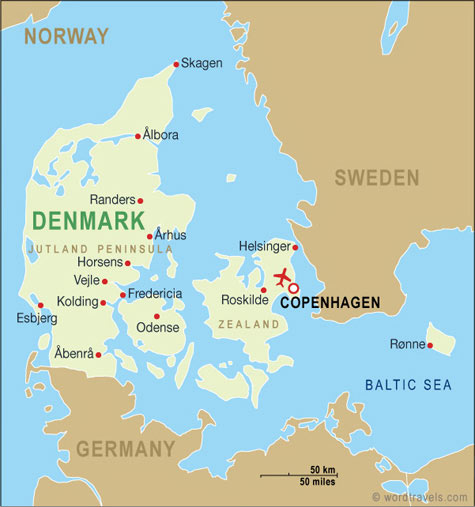Aarhus, Denmark's second city, has youthful flair
 Aarhus, Denmark - Big cities in Denmark? Most people think of Copenhagen and then scratch their head. The second-largest city after the Danish capital is Aarhus, which has more than 300,000 inhabitants. In the half-century before 1909, its population increased tenfold. Touristically, Aarhus is a great alternative for anyone who has seen enough of Copenhagen.
Aarhus, Denmark - Big cities in Denmark? Most people think of Copenhagen and then scratch their head. The second-largest city after the Danish capital is Aarhus, which has more than 300,000 inhabitants. In the half-century before 1909, its population increased tenfold. Touristically, Aarhus is a great alternative for anyone who has seen enough of Copenhagen.
The city lies on the east coast of Jutland, the Danish mainland. Queen Margrethe II of Denmark has a castle there. Crown Prince Frederik studied in Aarhus, which is not surprising since the University of Aarhus has a rather good reputation and is also, with nearly 35,000 students, the country's second-largest university. It is a big reason that the average age of the city's inhabitants is far lower than anywhere else in Denmark.
Annette Weyer, who moved to Aarhus from Berlin in 1976, said the city had changed dramatically over the past three decades. "It was completely different then. In the evening you often didn't know where to go," she remarked during a tour of the Latinerkvarter ("Latin Quarter"), the trendiest district in Aarhus.
Vestergade street is lined with cafes and art galleries. Quite a few fashion designers have set up shop there, too. Displayed on the side of one building is the famous "Nuclear Power? No, Thanks" sign, a smiling red sun in a yellow circle. In Germany, thousands of nuclear-power foes attached the sign to their car or the door of their shared flat.
"The sign was designed here in Aarhus," Weyer pointed out.
There are handsomely renovated half-timbered buildings, jewellery stores and handicrafts such as the glassblowing workshop of Mette Buelow Duus. The shelves are filled with vases of deep yellow and blue, and bowls whose bases are entwined like lianas. The creations are typical of Danish design -- chic, simple and a little different - and suit the Latinerkvater perfectly.
So does Svieneriet, a restaurant a several-minute walk away. Its walls are covered with graffiti. The place is reminiscent of the eastern Berlin neighbourhood of Prenzlauer Berg before the parvenu double-earners took it over. The restaurant's ambience lies somewhere between cosy and sedate. Prices are similar to those in Prenzlauer Berg since the arrival of the double-earners.
Aarhus was always a bit avant-garde, a quality exemplified by its City Hall. Inaugurated in the 1940s and protected as a historic building, it was designed by Arne Jacobsen, regarded today as the Danish architect and designer par excellence. Some people drop by just to see the workplace of Hosea Che Dutschke, son of "Red" Rudi Dutschke, the best known of West Germany's 1968 student leaders. The younger Dutschke is employed by the municipal administration.
The first floor features a drinking-water reservoir, ashtrays and doorbell buttons with Jacobsen's designs. The tenth floor offers a panorama of the city: the harbour, ferries that go to places like the island of Zealand, cranes, containers and the city's roofs and streets.
The new ARoS Aarhus Art Museum is also rather avant-garde. It is located on the route to the city centre. Essentially, the route leads right through the museum because its street-level hall, where admission is free, is constantly being crossed by people who have not come to look at art.
"We're open for everyone," noted Martha Freud Abildgaard, event coordinator at the museum. ARoS does not want to be an out-of-the-way temple of art.
The collection is not at all ordinary. Contemporary art occupies the lowest floor. Above it is Danish Modernism, and works by Danish painters from 1770 to 1930 are on the uppermost level. Visitors should plan on staying more than half a day.
The biggest eyecatcher is "Boy," a five-metre-high sculpture of a crouching youth by Ron Muecks, an Australian. Opinions are divided on on whether he looks frightened or is perhaps smiling like Mona Lisa. (dpa)